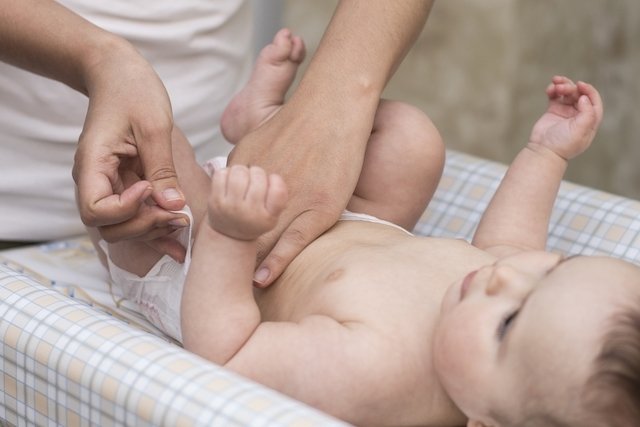The presence of blood in a baby’s diaper is always a cause for alarm for parents, however, in most cases the presence of blood in the diaper is not a sign of serious health problems, and may only arise due to more common situations such as diaper rash. butt, allergy to cow’s milk or anal fissure, for example.
Additionally, when a baby’s urine is very concentrated, it may contain urate crystals that give the urine a reddish or pink color, making it appear as if the baby has blood in the diaper.
To test whether there really is blood in the baby’s diaper, you can put a little hydrogen peroxide on the stain. If foam is produced, it means that the stain is actually blood and, therefore, it is important to consult your pediatrician to identify the cause and begin appropriate treatment.

Main causes
The main causes of blood in a baby’s diaper are:
1. Reddish foods
The baby’s poop can become reddish due to eating red foods such as beetroot, tomato soup or some food with red dye, for example, which can create the idea that the baby has blood in the diaper.
What to do: Avoid giving these foods to your baby and if the problem persists for more than 24 hours or is accompanied by symptoms such as fever, diarrhea or irritability, for example, you should consult your pediatrician to identify the problem and begin treatment.
Don’t ignore the signs your body is giving you!
2. Diaper rash
Diaper rash is the presence of irritated, red skin on the bottom that can bleed after cleaning the skin, causing bright red blood to appear in the diaper.
What to do: If possible, leave the baby without a diaper for a few hours a day. Furthermore, it is important to avoid using wet wipes, and the baby’s bottom should be washed with water and neutral soap, dry well and apply an ointment for diaper rash that contains zinc oxide, such as Dermodex or Bepantol, for example, in every diaper change. See all the necessary care to take care of your baby’s diaper rash.
3. Cow’s milk allergy
The presence of blood in the baby’s stool may also indicate that the baby is allergic to cow’s milk protein, for example. Even in babies who only breastfeed, cow’s milk protein can be passed to the baby through breast milk when the mother ingests cow’s milk and its derivatives.
What to do: Remove cow’s milk from the baby’s or mother’s diet and observe whether blood continues to appear in the diaper. See how to identify if your baby is allergic to milk protein and what to do.
4. Anal fissure
The existence of blood in the diaper of a baby who is frequently constipated may be a sign of a fissure in the anal region, as the baby’s feces can become very hard and, when they come out, cause a small cut in the anus.
What to do: give breast milk freely, offer more water to the baby, give juices and soups, as well as make porridges with more water to make them less consistent, as the increased consumption of liquids helps to hydrate the feces, making them easier to eliminate . See also a home remedy for constipation in babies.
5. Rotavirus Vaccine
One of the main side effects of the Rotavirus vaccine is the presence of blood in the baby’s stool up to 40 days after taking the vaccine. Therefore, if this happens, it should not be given any importance, as long as the amount of blood is small.
What to do: If the baby is losing a lot of blood through feces, it is advisable to go to the emergency room immediately so that the pediatrician can carry out a more detailed assessment.
6. Very concentrated urine
When a baby’s urine becomes very concentrated, urate crystals are eliminated in the urine, giving it a reddish color that can look like blood. In these cases, when testing with hydrogen peroxide, the “blood” does not produce foam and, therefore, it is possible to suspect that it is just very concentrated urine.
What to do: increase the amount of water or breast milk given to the baby, depending on age, to reduce the concentration of urine and urate crystals.
7. Intestinal infection
A serious intestinal infection can injure the intestine internally and cause bleeding that comes out in the feces, usually accompanied by abdominal pain and diarrhea, and vomiting and fever. Check out other symptoms that may indicate an intestinal infection in your baby.
What to do: It is important to take the baby to the hospital immediately to identify the cause and start the most appropriate treatment. In addition, adequate hydration should also be maintained through the intake of water, soups, juices and oral rehydration salts to avoid dehydration.
When to go to the doctor
Although in most cases blood in a diaper is not an emergency situation, it is recommended to go to the emergency room when:
- The baby is bleeding excessively;
- Other symptoms appear, such as fever above 38º, diarrhea or excessive desire to sleep;
- The baby doesn’t have the energy to play.
In these cases, the baby must be evaluated by a pediatrician to carry out urine, feces or blood tests and identify the cause, starting appropriate treatment, if necessary.

Sign up for our newsletter and stay up to date with exclusive news
that can transform your routine!
Warning: Undefined array key "title" in /home/storelat/public_html/wp-content/plugins/link-whisper-premium/templates/frontend/related-posts.php on line 12
Warning: Undefined array key "title_tag" in /home/storelat/public_html/wp-content/plugins/link-whisper-premium/templates/frontend/related-posts.php on line 13



